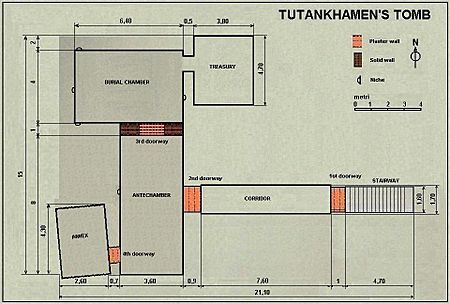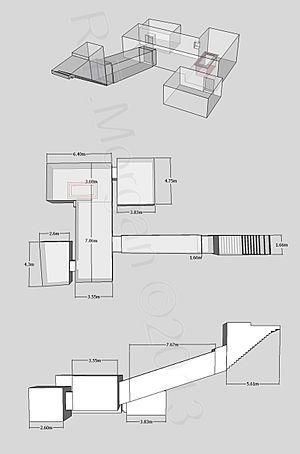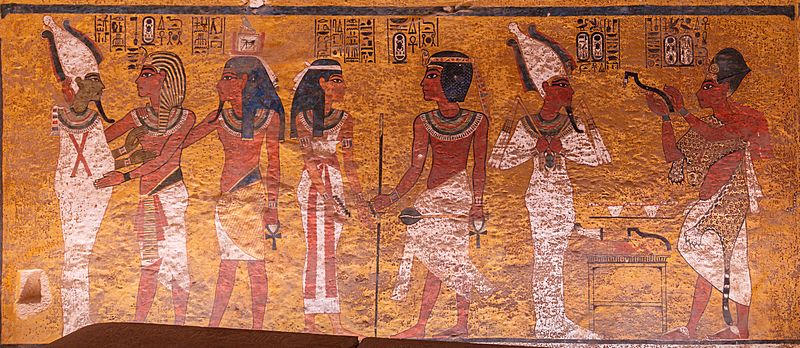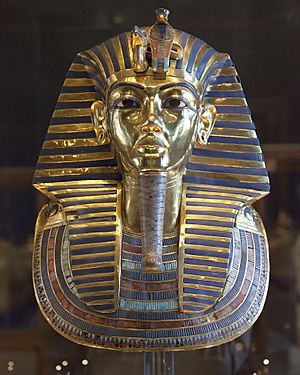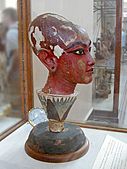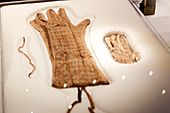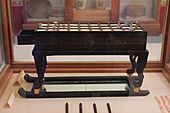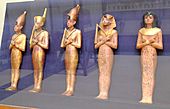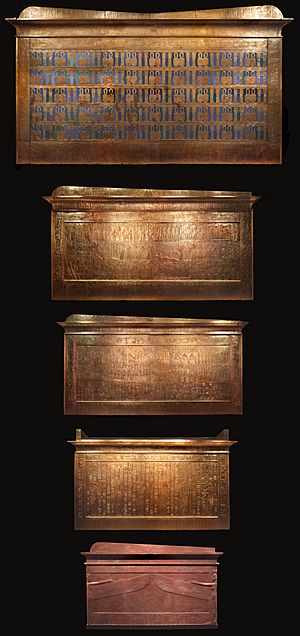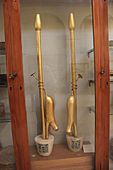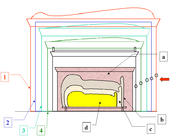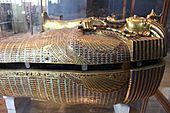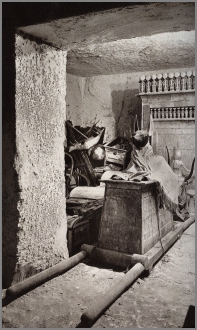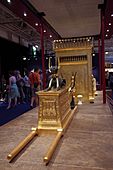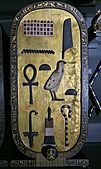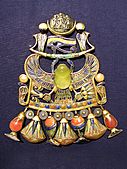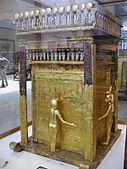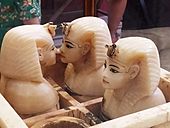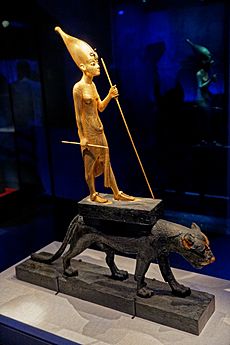Tomb of Tutankhamun facts for kids
Quick facts for kids KV62 |
|||
|---|---|---|---|
| Burial site of Tutankhamun | |||

The wall decorations in KV62's burial chamber
are modest in comparison with other royal tombs found in the Valley of the Kings. |
|||
| Coordinates | 25°44′25.4″N 32°36′05.1″E / 25.740389°N 32.601417°E | ||
| Location | East Valley of the Kings | ||
| Discovered | 4 November 1922 | ||
| Excavated by | Howard Carter | ||
| Decoration |
|
||
| Layout | Bent to the right | ||
|
|||
The tomb of Tutankhamun, also known by its tomb number, KV62, is the burial place of Tutankhamun (reigned c. 1332–1323 BC), a pharaoh of the Eighteenth Dynasty of ancient Egypt, in the Valley of the Kings. The tomb consists of four chambers and an entrance staircase and corridor. It is smaller and less extensively decorated than other Egyptian royal tombs of its time, and it probably originated as a tomb for a non-royal individual that was adapted for Tutankhamun's use after his premature death. Like other pharaohs, Tutankhamun was buried with a wide variety of funerary objects and personal possessions, such as coffins, furniture, clothing and jewelry, though in the unusually limited space these goods had to be densely packed. Robbers entered the tomb twice in the years immediately following the burial, but Tutankhamun's mummy and most of the burial goods remained intact. The tomb's low position, dug into the floor of the valley, allowed its entrance to be hidden by debris deposited by flooding and tomb construction. Thus, unlike other tombs in the valley, it was not stripped of its valuables during the Third Intermediate Period (c. 1070–664 BC).
Tutankhamun's tomb was discovered in 1922 by excavators led by Howard Carter. As a result of the quantity and spectacular appearance of the burial goods, the tomb attracted a media frenzy and became the most famous find in the history of Egyptology. The death of Carter's patron, the Earl of Carnarvon, in the midst of the excavation process inspired speculation that the tomb was cursed. The discovery produced only limited evidence about the history of Tutankhamun's reign and the Amarna Period that preceded it, but it provided insight into the material culture of wealthy ancient Egyptians as well as patterns of ancient tomb robbery. Tutankhamun became one of the best-known pharaohs, and some artefacts from his tomb, such as his golden funerary mask, are among the best-known artworks from ancient Egypt.
Most of the tomb's goods were sent to the Egyptian Museum in Cairo and are now in the Grand Egyptian Museum in Giza, although Tutankhamun's mummy and sarcophagus are still on display in the tomb. Flooding and heavy tourist traffic have inflicted damage on the tomb since its discovery, and a replica of the burial chamber has been constructed nearby to reduce tourist pressure on the original tomb.
Architecture
Tutankhamun's tomb lies in the eastern branch of the Valley of the Kings, where most tombs in the valley are located. It is cut into the limestone bedrock in the valley floor, on the west side of the main path, and runs beneath a low foothill. Its design is similar to those of non-royal tombs from its time, but elaborated so as to resemble the conventional plan of a royal tomb. It consists of a westward-descending stairway (labeled A in the conventional Egyptological system for designating parts of royal tombs in the valley); an east–west descending corridor (B); an antechamber at the west end of the passage (I); an annexe adjoining the southwest corner of the antechamber (Ia); a burial chamber north of the antechamber (J); and a room east of the burial chamber (Ja), known as the treasury. The burial chamber and treasury may have been added to the original tomb when it was adapted for Tutankhamun's burial. Most Eighteenth Dynasty royal tombs used a layout with a bent axis, so that a person moving from the entrance to the burial chamber would take a sharp turn to the left along the way. By placing Tutankhamun's burial chamber north of the antechamber, the builders of KV62 gave it a layout with an axis bent to the right rather than the left.
The entrance stair descends steeply beneath an overhang. It originally consisted of sixteen steps. The lowest six were cut away during the burial to make room to maneuver the largest pieces of funerary furniture through the doorway, then rebuilt, then removed again 3,400 years later when the excavators removed that same furniture. The corridor is 8 metres (26 ft) long and 1.7 metres (5 ft 7 in) wide; the antechamber is 7.9 metres (26 ft) north–south by 3.6 metres (12 ft) east–west; the annexe is 4.4 metres (14 ft) north–south by 2.6 metres (8 ft 6 in) east–west; the burial chamber is 4 metres (13 ft) north–south by 6.4 metres (21 ft) east–west; and the treasury is 4.8 metres (16 ft) north–south by 3.8 metres (12 ft) east–west. The chambers range from 2.3 metres (7 ft 7 in) to 3.6 metres (12 ft) high, and the floors of the annexe, burial chamber and treasury are about 0.9 metres (2 ft 11 in) below the floor of the antechamber. In the west wall of the antechamber is a small niche for a beam that was used for manoeuvring the sarcophagus through the room. The burial chamber contains four niches, one in each wall, in which were placed "magic bricks" inscribed with protective spells.
Partitions constructed of limestone and plaster originally sealed the doorways between the stairway and the corridor; between the corridor and the antechamber; between the antechamber and the annexe; and between the antechamber and the burial chamber. All were breached by robbers. Most were resealed by the restorers, but the robbers' hole in the annexe doorway was left open.
There are several faults in the rock into which the tomb is cut, including a large one that runs south-southeast to north-northwest across the antechamber and burial chamber. Although the workmen who cut the tomb sealed the fault in the burial chamber with plaster, the faults are responsible for the water seepage that affects the tomb.
Decoration
The plaster partitions were marked with impressions from seals borne by various officials who oversaw Tutankhamun's burial and the restoration efforts. These seals consist of hieroglyphic text that celebrates Tutankhamun's services to the gods during his reign.
Aside from these seal impressions, the only wall decoration in the tomb is in the burial chamber. This limited decorative programme contrasts with other royal tombs of the late Eighteenth Dynasty, in which two chambers in addition to the burial chamber often received decoration, and with the practice in the Nineteenth and Twentieth Dynasties, in which all parts of the tomb were decorated. None of the decoration is executed in relief, a technique that was not used in the Valley of the Kings until the reign of Horemheb.
KV62's burial chamber is painted with figures on a yellow background. The east wall portrays Tutankhamun's funeral procession, a type of image that is common in private New Kingdom tombs but not found in any other royal tomb. The north wall shows Ay performing the Opening of the Mouth ritual upon Tutankhamun's mummy, thus legitimising him as the king's heir, and then Tutankhamun greeting the goddess Nut and the god Osiris in the afterlife. The south wall portrayed the king with the deities Hathor, Anubis and Isis. Part of the decoration of this wall was painted on the partition dividing the burial chamber from the antechamber, and thus the figure of Isis had to be destroyed when the partition was demolished during the tomb clearance. The west wall bears an image of twelve baboons, which is an extract from the first section of the Amduat, a funerary text that describes the journey of the sun god Ra through the netherworld. On three walls the figures are given the unusual proportions found in the art style of the Amarna Period, although the south wall reverts to the conventional proportions found in art before and after Amarna.
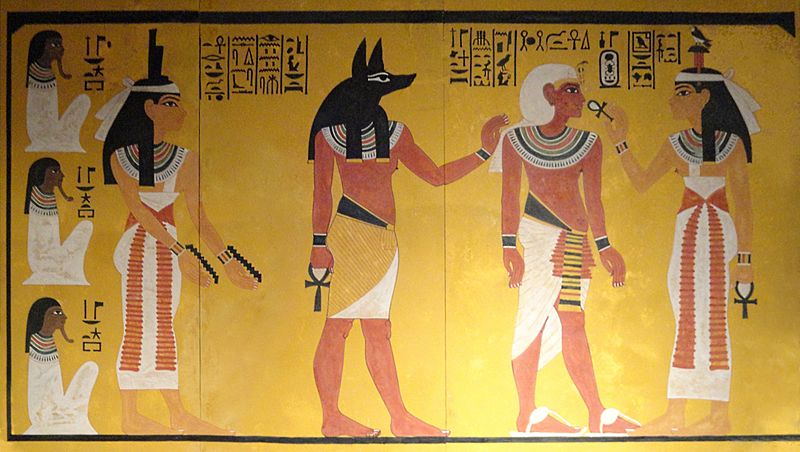
Burial goods
The contents of the tomb are by far the most complete example of a royal set of burial goods in the Valley of the Kings, numbered at 5,398 objects. Some classes of object number in the hundreds: there are 413 shabtis (figurines intended to do work for the king in the afterlife) and more than 200 pieces of jewellery. Objects were present in all four chambers in the tomb as well as the corridor.
The efforts of the robbers, followed by the hasty restoration effort, left much of the tomb in disarray when it was last sealed. By the time of the discovery, many of the objects had been damaged by alternating periods of humidity and dryness. Nearly all leather in the tomb had dissolved into a pitch-like mass, and while the state of preservation of textiles was highly inconsistent, the worst-preserved had turned into a black powder. Wooden objects were warped and their glues dissolved, leaving them in a very fragile state. Every exposed surface was covered with an unidentified pink film; Lucas suggested it was some kind of dissolved iron compound that came from the rock or the plaster. In the process of cleaning, restoring and removing the damaged artefacts, the excavators labeled each object or group of objects with a number, from 1 to 620, appending letters to distinguish individual objects within a group.
Outer chambers
The corridor may have contained miscellaneous materials, such as bags of natron, jars and flower garlands, that were moved to KV54 when the corridor was filled after the first robbery. Other objects and fragments were incorporated into the corridor fill. One well-known artefact, a wooden bust of Tutankhamun, was apparently found in the corridor when it was excavated, but it was not recorded in Carter's initial excavation notes.
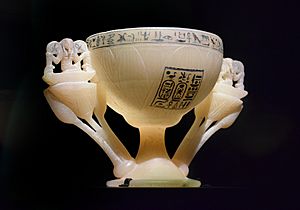
The antechamber contained 600 to 700 objects. Its west side was taken up by a tangled pile of furniture among which miscellaneous small objects, such as baskets of fruit and boxes of meat, were placed. Several dismantled chariots took up the southeast corner, while the northeast contained a collection of funerary bouquets and the north end of the chamber was dominated by two life-size statues of Tutankhamun that flanked the entrance to the burial chamber. These statues are thought to have either served as guardians of the burial chamber or as figures representing the king's ka, an aspect of his soul. Among the significant objects in the antechamber were several funerary beds with animal heads, which dominated the cluster of furniture against the west wall; an alabaster lotus chalice; and a painted box depicting Tutankhamun in battle, which Carter regarded as one of the finest works of art in the tomb. Carter thought even more highly of a gilded and inlaid throne depicting Tutankhamun and Ankhesenamun in the art style of the Amarna Period; he called it "the most beautiful thing that has yet been found in Egypt". Boxes in the antechamber contained most of the clothing in the tomb, including tunics, shirts, kilts, gloves and sandals, as well as cosmetics such as unguents and kohl. Scattered in various places in the antechamber were pieces of gold and semiprecious stones from a corselet, a ceremonial version of the armor that Egyptian kings wore into battle. Reconstructing the corselet was one of the most complex tasks the excavators faced. This room also contained a wooden dummy of Tutankhamun's head and torso. Its purpose is uncertain, although it bears marks that may indicate it once wore a corselet, and Carter suggested it was a mannequin for the king's clothes.
The annexe contained more than 2,000 individual artefacts. Its original contents were jumbled together with objects that had been haphazardly replaced during the restoration after the robberies, including beds, stools, and stone and pottery vessels containing wine and oils. The room housed most of the tomb's foodstuffs, most of the shabtis and many of its wooden funerary models, such as models of boats. Much of the weaponry in the tomb, such as bows, throwing sticks and khopesh-swords, as well as ceremonial shields, were found here. Other objects in the annexe were personal possessions that Tutankhamun seemingly used as a child, such as toys, a box of paints and a fire-lighting kit.
-
A senet game-board from the annexe
Burial chamber
Most of the space in the burial chamber was taken up by the gilded wooden outer shrine enclosing three nested inner shrines and, within them, a stone sarcophagus containing three nested coffins. Also a wooden frame stood between the outermost and second shrines which was covered with a blue linen pall spangled with bronze rosettes. Yet even this chamber contained burial goods, including jars, religious objects such as imiut fetishes, oars, fans and walking sticks, some of which were inserted in the narrow gaps between shrines. Each wall of the chamber bore a niche containing a brick, of a type that Egyptologists call "magic bricks", because they are inscribed with passages from Spell 151 from the funerary text known as the Book of the Dead, and are intended to ward off threats to the dead.
The decoration of the shrines, executed in relief, includes portions of several funerary texts. All four shrines bear extracts from the Book of the Dead, and further extracts from the Amduat are on the third shrine. The outermost shrine is inscribed with the earliest known copy of the Book of the Heavenly Cow, which describes how Ra reshaped the world into its current form. The second shrine bears a funerary text that is found nowhere else, although texts with similar themes are known from the tombs of Ramesses VI (KV9) and Ramesses IX (KV6). Like them, it describes the sun god and the netherworld using a cryptic form of hieroglyphic writing that uses non-standard meanings for each hieroglyphic sign. These three texts are sometimes labeled "enigmatic books" or "books of the solar-Osirian unity".
The sarcophagus is made of quartzite but with a red granite lid, painted yellow to match the quartzite. It is carved with the images of four protective goddesses (Isis, Nephthys, Neith and Serqet), and contained a golden lion-headed bier on which rested three nested coffins in human shape.
The outer two coffins were made of gilded wood inlaid with glass and semiprecious stones, while the innermost coffin, though similarly inlaid, was primarily composed of 110.4 kilograms (243 lb) of solid gold. Within it lay Tutankhamun's mummified body. On the body, and contained within the layers of mummy wrappings, were 143 items, including articles of clothing such as sandals, a plethora of amulets and other jewellery and two daggers. Tutankhamun's head bore a beaded skullcap and a gold diadem, all of which was encased in the golden mask of Tutankhamun, which has become one of the most iconic ancient Egyptian artefacts in the world.
Treasury
In the doorway of the treasury stood a shrine on carrying poles topped by a statue of the jackal god Anubis, in front of which lay a fifth magic brick. Against the east wall of the treasury was a tall gilded shrine containing the canopic chest, in which Tutankhamun's internal organs were placed after mummification. Whereas most canopic chests contain separate jars, Tutankhamun's consists of a single block of alabaster carved into four compartments, each covered by a human-headed stopper and containing an inlaid gold coffinette that housed one of the king's organs. Between the Anubis shrine and the canopic shrine stood a wooden sculpture of a cow's head, representing the goddess Hathor. The treasury was the location of most of the tomb's wooden models, including more boats and a model granary, as well as many of the shabtis. Boxes in the treasury contained miscellaneous items, including much of the tomb's jewellery. A nested set of small coffins in the treasury contained a lock of hair belonging to Tiye, the wife of Amenhotep III, who is thought to have been Tutankhamun's grandmother. One box contained two miniature coffins in which mummies of Tutankhamun's stillborn daughters were interred.
-
Portable shrine with a statue Anubis, exposition in Paris
-
A box from the treasury shaped like the cartouche of Tutankhamun's name
-
A pendant in the shape of a winged scarab carrying the Eye of Horus, from the treasury
Significance
The volume of goods in Tutankhamun's tomb is often taken as a sign that longer-lived kings who had full-size tombs were buried with an even larger array of objects. Yet Tutankhamun's burial goods barely fit into his tomb, so the Egyptologist Joyce Tyldesley argues that larger tombs in the valley may have contained assemblages of similar size that were arranged in a more orderly and spacious manner.
The fragmentary remains of burial goods in other tombs in the Valley of the Kings include many of the same objects found in Tutankhamun's, implying that there was a somewhat standard set of object types for royal burials in this era. The life-size statues of Tutankhamun and the statuettes of deities have parallels in several other tombs in the valley, while the statuettes of Tutankhamun himself are closely paralleled by wall paintings in KV15, the tomb of Seti II. Funerary models, such as Tutankhamun's model boats, were mainly a feature of burials in the Old and Middle Kingdoms and fell out of favour in non-royal burials in the New, but several royal tombs in the Valley of the Kings contained them. Conversely, Tutankhamun's tomb contained no funerary texts on papyri, unlike private tombs from its era, but the existence of an excerpt of the Book of the Dead on a papyrus from KV35, the tomb of Amenhotep II, suggests that their absence in Tutankhamun's tomb may have been unusual.
No papyrus texts at all were among the burial goods—a disappointment to Egyptologists, who hoped to find documents that would clarify the history of the Amarna Period. Instead much of the value of the discovery was in the insight it provided into the material culture of ancient Egypt. Among the furniture was a foldable bed, the only intact example known from ancient Egypt. Some of the boxes could be latched with the turn of a knob, and Carter called them the oldest known examples of such a mechanism. Other everyday items include musical instruments, such as a pair of trumpets; a variety of weapons, including a dagger made of iron, a rare commodity in Tutankhamun's time; and about 130 staffs, including one bearing the label "a reed staff which His Majesty cut with his own hand."
Tutankhamun's clothes—loose tunics, robes and sashes, often elaborately decorated with dye, embroidery or beadwork—exhibit more variety than the clothes depicted in art from his time, which consist largely of plain white kilts and tight sheaths. No crowns were found in the tomb, although crooks and flails, which also served as emblems of kingship, were stored there. Tyldesley suggests that crowns may have not been considered personal property of the king and were instead passed down from reign to reign.
Some of the objects in the tomb shed limited light on the end of the Amarna Period. A piece of a box found in the corridor bears the names of Akhenaten, Neferneferuaten and Akhenaten's daughter Meryetaten, while a calcite jar from the tomb bore two erased royal names that have been reconstructed as those of Akhenaten and Smenkhkare. These are key pieces of evidence in attempts to reconstruct the relationships between members of the royal family and the sequence in which they reigned, although scholars' interpretations have varied greatly. The faces of Tutankhamun's second coffin and his canopic coffinettes differ from the faces of most portrayals of him, so these items may originally have been made for another ruler, such as Smenkhkare or Neferneferuaten, and reused for Tutankhamun's burial.
Some objects bear evidence of the shift in religious policy in Tutankhamun's reign. The golden throne portrays Tutankhamun and Ankhesenamun beneath the rays of the Aten, in the Amarna art style. The king and queen are labeled with the later forms of their names, referring to Amun rather than the Aten, but there are signs that these labels were altered after the throne was made, and the open-work arms and back of the throne bear the king's original name, Tutankhaten. A sceptre from the annexe bears an inscription mentioning both the Aten and Amun, implying an attempt to integrate the two religious systems.
Other information about the reign is provided by the labels on wine jars, which are labeled by the year in which they were produced. Jars that are explicitly labeled as coming from Tutankhamun's reign range from Year 5 to Year 9, while one jar from an unidentified reign is labeled Year 10 and another Year 31. The Year 31 wine probably comes from the reign of Amenhotep III, so the remaining jars suggest that Tutankhamun reigned for nine or ten years. The flowers and fruits in the funerary garlands would have been available from mid-March to mid-April, indicating that Tutankhamun's funeral took place then. The royal annals of the Hittite Empire record a letter from an unnamed Egyptian queen, referred to as "Dakhamunzu", recently widowed by the death of a pharaoh and offering to marry a Hittite prince. The dead king is most commonly thought to be Tutankhamun, and Ankhesenamun the sender of the letter, but the letter indicates the king in question died in August or September, meaning either that Tutankhamun was not the king in the Hittite annals or that he remained unburied far longer than the traditional 70-day period of mummification and mourning.
The thefts make Tutankhamun's tomb one of the most important sources for understanding tomb robbery and restoration in the New Kingdom, particularly for the early part of that period, when robberies were more opportunistic than the large-scale plundering that took place in the late Twentieth Dynasty. Many of the boxes in the tomb bear dockets in hieratic writing that list their original contents, making it possible to partially reconstruct what the tomb originally held and which items were lost. The dockets of the jewellery boxes in the treasury, for instance, indicate that about 60 percent of their contents is missing. Thieves would have prized what was valuable, portable and either untraceable or possible to disguise through dismantling or melting. Most of the metal vessels originally buried with Tutankhamun were stolen, as were those of glass, indicating that glass was a valuable commodity at the time. The robbers also took bedding and cosmetics; the theft of the latter shows that the robberies took place soon after burial, as the Egyptians' fat-based unguents would have turned rancid within a few years. One of the boxes in the antechamber contained a set of gold rings wrapped in a scarf, which Carter believed had been dropped by the thieves and placed in the box by the restorers. The unlikelihood that robbers would forget something so valuable led him to suggest they had been caught in the act. The broken objects found in the fill of the corridor all came from the antechamber, implying that the first group of thieves only had access to that chamber and that it was the second group who reached as far as the treasury.
A man named Djehutymose, apparently the official who carried out the restoration of the tomb, wrote his name on a jar stand in the annexe. The same man left a note in KV43, the tomb of Thutmose IV, recording the restoration of that tomb in Year 8 of the reign of Horemheb. These two tombs were among several in the Valley of the Kings that were robbed at the end of the Eighteenth Dynasty, suggesting that political uncertainty following Tutankhamun's death caused a weakening of security there.



